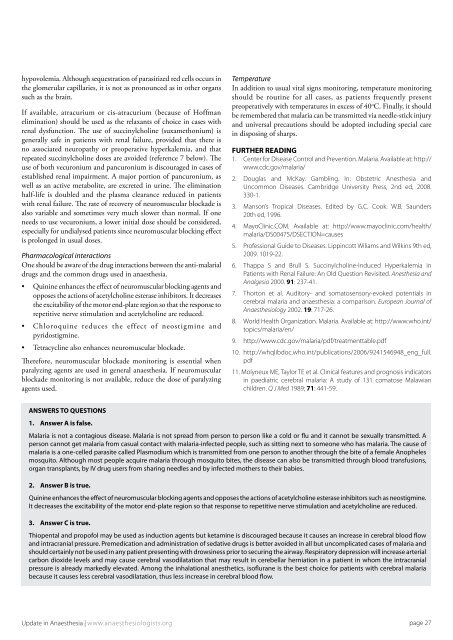Surgically placed rectus sheath catheters - The Global Regional ...
Surgically placed rectus sheath catheters - The Global Regional ...
Surgically placed rectus sheath catheters - The Global Regional ...
Create successful ePaper yourself
Turn your PDF publications into a flip-book with our unique Google optimized e-Paper software.
hypovolemia. Although sequestration of parasitized red cells occurs in<br />
the glomerular capillaries, it is not as pronounced as in other organs<br />
such as the brain.<br />
If available, atracurium or cis-atracurium (because of Hoffman<br />
elimination) should be used as the relaxants of choice in cases with<br />
renal dysfunction. <strong>The</strong> use of succinylcholine (suxamethonium) is<br />
generally safe in patients with renal failure, provided that there is<br />
no associated neuropathy or preoperative hyperkalemia, and that<br />
repeated succinylcholine doses are avoided (reference 7 below). <strong>The</strong><br />
use of both vecuronium and pancuronium is discouraged in cases of<br />
established renal impairment. A major portion of pancuronium, as<br />
well as an active metabolite, are excreted in urine. <strong>The</strong> elimination<br />
half-life is doubled and the plasma clearance reduced in patients<br />
with renal failure. <strong>The</strong> rate of recovery of neuromuscular blockade is<br />
also variable and sometimes very much slower than normal. If one<br />
needs to use vecuronium, a lower initial dose should be considered,<br />
especially for undialysed patients since neuromuscular blocking effect<br />
is prolonged in usual doses.<br />
Pharmacological interactions<br />
One should be aware of the drug interactions between the anti-malarial<br />
drugs and the common drugs used in anaesthesia.<br />
• Quinine enhances the effect of neuromuscular blocking agents and<br />
opposes the actions of acetylcholine esterase inhibitors. It decreases<br />
the excitability of the motor end-plate region so that the response to<br />
repetitive nerve stimulation and acetylcholine are reduced.<br />
• Chloroquine reduces the effect of neostigmine and<br />
pyridostigmine.<br />
• Tetracycline also enhances neuromuscular blockade.<br />
<strong>The</strong>refore, neuromuscular blockade monitoring is essential when<br />
paralyzing agents are used in general anaesthesia. If neuromuscular<br />
blockade monitoring is not available, reduce the dose of paralyzing<br />
agents used.<br />
Temperature<br />
In addition to usual vital signs monitoring, temperature monitoring<br />
should be routine for all cases, as patients frequently present<br />
preoperatively with temperatures in excess of 40 o C. Finally, it should<br />
be remembered that malaria can be transmitted via needle-stick injury<br />
and universal precautions should be adopted including special care<br />
in disposing of sharps.<br />
FURTHER READING<br />
1. Center for Disease Control and Prevention. Malaria. Available at: http://<br />
www.cdc.gov/malaria/<br />
2. Douglas and McKay. Gambling. In: Obstetric Anesthesia and<br />
Uncommon Diseases. Cambridge University Press, 2nd ed, 2008.<br />
330-1.<br />
3. Manson’s Tropical Diseases. Edited by G.C. Cook. W.B. Saunders<br />
20th ed, 1996.<br />
4. MayoClinic.COM. Available at: http://www.mayoclinic.com/health/<br />
malaria/DS00475/DSECTION=causes<br />
5. Professional Guide to Diseases. Lippincott Wiliams and Wilkins 9th ed,<br />
2009. 1019-22.<br />
6. Thappa S and Brull S. Succinylcholine-Induced Hyperkalemia in<br />
Patients with Renal Failure: An Old Question Revisited. Anesthesia and<br />
Analgesia 2000. 91: 237-41.<br />
7. Thorton et al. Auditory- and somatosensory-evoked potentials in<br />
cerebral malaria and anaesthesia: a comparison. European Journal of<br />
Anaesthesiology 2002. 19: 717-26.<br />
8. World Health Organization. Malaria. Available at: http://www.who.int/<br />
topics/malaria/en/<br />
9. http://www.cdc.gov/malaria/pdf/treatmenttable.pdf<br />
10. http://whqlibdoc.who.int/publications/2006/9241546948_eng_full.<br />
pdf<br />
11. Molyneux ME, Taylor TE et al. Clinical features and prognosis indicators<br />
in paediatric cerebral malaria: A study of 131 comatose Malawian<br />
children. Q J Med 1989; 71: 441-59.<br />
ANSWERS TO QUESTIONS<br />
1. Answer A is false.<br />
Malaria is not a contagious disease. Malaria is not spread from person to person like a cold or flu and it cannot be sexually transmitted. A<br />
person cannot get malaria from casual contact with malaria-infected people, such as sitting next to someone who has malaria. <strong>The</strong> cause of<br />
malaria is a one-celled parasite called Plasmodium which is transmitted from one person to another through the bite of a female Anopheles<br />
mosquito. Although most people acquire malaria through mosquito bites, the disease can also be transmitted through blood transfusions,<br />
organ transplants, by IV drug users from sharing needles and by infected mothers to their babies.<br />
2. Answer B is true.<br />
Quinine enhances the effect of neuromuscular blocking agents and opposes the actions of acetylcholine esterase inhibitors such as neostigmine.<br />
It decreases the excitability of the motor end-plate region so that response to repetitive nerve stimulation and acetylcholine are reduced.<br />
3. Answer C is true.<br />
Thiopental and propofol may be used as induction agents but ketamine is discouraged because it causes an increase in cerebral blood flow<br />
and intracranial pressure. Premedication and administration of sedative drugs is better avoided in all but uncomplicated cases of malaria and<br />
should certainly not be used in any patient presenting with drowsiness prior to securing the airway. Respiratory depression will increase arterial<br />
carbon dioxide levels and may cause cerebral vasodilatation that may result in cerebellar herniation in a patient in whom the intracranial<br />
pressure is already markedly elevated. Among the inhalational anesthetics, isoflurane is the best choice for patients with cerebral malaria<br />
because it causes less cerebral vasodilatation, thus less increase in cerebral blood flow.<br />
Update in Anaesthesia | www.anaesthesiologists.org<br />
page 27
















